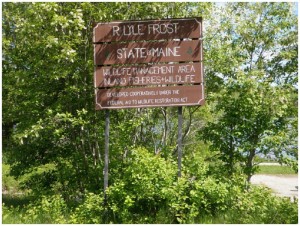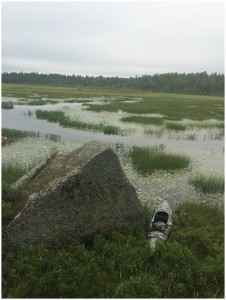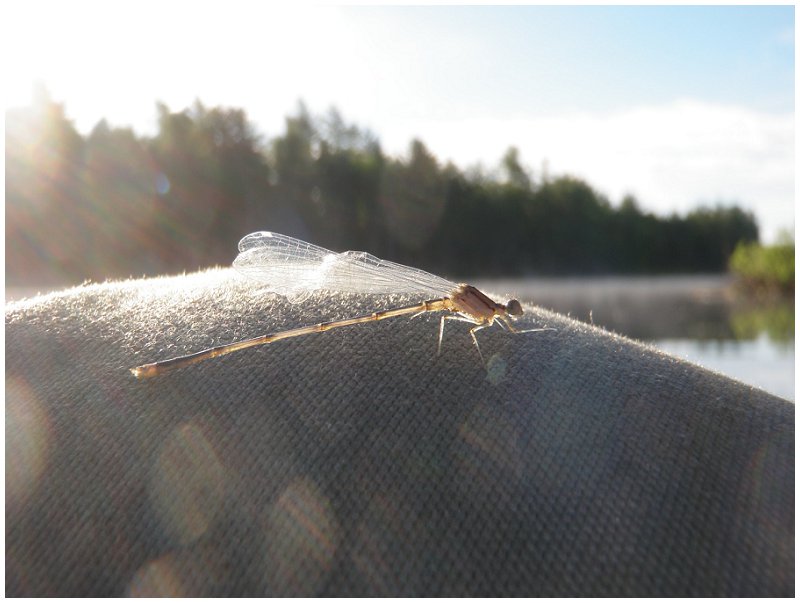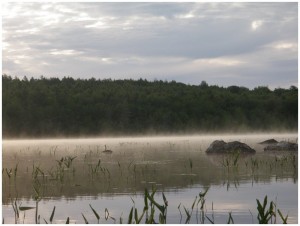August 4, 2015 at 3:37 pm
 Written by Sarah Spencer, Wildlife Biologist
It’s four a.m. With barely enough light in the sky to see what we’re doing, but it’s time to start the day. This morning’s task is conducting a waterfowl brood survey at Lyle Frost Wildlife Management Area in Eastbrook. These surveys are conducted twice each year, in June and again in July, at the same locations year after year, providing an index of waterfowl production to better inform our management decisions. The survey starts 30 minutes prior to sunrise so we unload our kayaks and load our gear for an early start. Lyle Frost WMA includes Scammon Marsh, a 658 acre impounded wetland, and we conduct the survey with two biologists. By 4:15 we can see well enough to identify waterfowl and their young so we slip into our kayaks quietly to start the survey.
The sky is overcast and a light fog covers the surface of the water, perfect conditions for a brood survey. These conditions allow us to identify and count each group of birds before they detect we are there. This is important for two reasons: we don’t want to separate a hen from her brood of ducklings, and we want to collect the most information possible on each group of birds we see.
Written by Sarah Spencer, Wildlife Biologist
It’s four a.m. With barely enough light in the sky to see what we’re doing, but it’s time to start the day. This morning’s task is conducting a waterfowl brood survey at Lyle Frost Wildlife Management Area in Eastbrook. These surveys are conducted twice each year, in June and again in July, at the same locations year after year, providing an index of waterfowl production to better inform our management decisions. The survey starts 30 minutes prior to sunrise so we unload our kayaks and load our gear for an early start. Lyle Frost WMA includes Scammon Marsh, a 658 acre impounded wetland, and we conduct the survey with two biologists. By 4:15 we can see well enough to identify waterfowl and their young so we slip into our kayaks quietly to start the survey.
The sky is overcast and a light fog covers the surface of the water, perfect conditions for a brood survey. These conditions allow us to identify and count each group of birds before they detect we are there. This is important for two reasons: we don’t want to separate a hen from her brood of ducklings, and we want to collect the most information possible on each group of birds we see. I paddle my kayak quietly for a few minutes before I see my first birds. A pair of wood ducks swim quickly out of sight, but I see no ducklings. Soon after, a kingfisher flies by and I hear the sound of a male red-winged blackbird calling, then a second, third; this part of the marsh is teaming with them. I see a motion in my peripheral vision and look to see a great blue heron flying by nearly silently. As the light level increases, so does my sightings of eastern Kingbirds foraging near the water. I see something that catches my eye, a common loon incubating an egg; I look forward to seeing a loon chick on my next visit. Pretty soon I start seeing more and more waterfowl and I’m amazed by the number of wood ducks I see. After what seems like forever, I finally see my first brood, a female black duck with four ducklings. She sees me before I’m able to lift my binoculars and I barely identify them before they swim out of view into the fog.
The birds seem to be everywhere this morning but then other wildlife begin to appear. It starts with beaver swimming circles around my kayak, then a lodge appears through the fog and I hear a beaver slap its tail on the water. I hear some splashing ahead and as I scan the edge of the water for waterfowl I see a river otter and two pups. A spotted sandpiper flies by the front of my kayak and as I paddle away from the river otters I realize I’ve been under the watchful eye of a bald eagle. The fog starts to lift and the sun becomes more visible as the clouds break up. An emerging damselfly finds its way onto my kayak and I watch as its wings unfold for the first time. I continue to see beaver, wood ducks, and painted turtles; then another brood, this time a hooded merganser with her four young. I see more wood ducks but none with ducklings, several more beaver, then another hooded merganser, this time with two ducklings. Movement along a line of emergent vegetation gives away the location of five small ducklings disappearing behind the vegetation; I’m too late this time to identify the species, never seeing the hen leading them away. Maybe I’ll spot them again on the next visit.
I paddle my kayak quietly for a few minutes before I see my first birds. A pair of wood ducks swim quickly out of sight, but I see no ducklings. Soon after, a kingfisher flies by and I hear the sound of a male red-winged blackbird calling, then a second, third; this part of the marsh is teaming with them. I see a motion in my peripheral vision and look to see a great blue heron flying by nearly silently. As the light level increases, so does my sightings of eastern Kingbirds foraging near the water. I see something that catches my eye, a common loon incubating an egg; I look forward to seeing a loon chick on my next visit. Pretty soon I start seeing more and more waterfowl and I’m amazed by the number of wood ducks I see. After what seems like forever, I finally see my first brood, a female black duck with four ducklings. She sees me before I’m able to lift my binoculars and I barely identify them before they swim out of view into the fog.
The birds seem to be everywhere this morning but then other wildlife begin to appear. It starts with beaver swimming circles around my kayak, then a lodge appears through the fog and I hear a beaver slap its tail on the water. I hear some splashing ahead and as I scan the edge of the water for waterfowl I see a river otter and two pups. A spotted sandpiper flies by the front of my kayak and as I paddle away from the river otters I realize I’ve been under the watchful eye of a bald eagle. The fog starts to lift and the sun becomes more visible as the clouds break up. An emerging damselfly finds its way onto my kayak and I watch as its wings unfold for the first time. I continue to see beaver, wood ducks, and painted turtles; then another brood, this time a hooded merganser with her four young. I see more wood ducks but none with ducklings, several more beaver, then another hooded merganser, this time with two ducklings. Movement along a line of emergent vegetation gives away the location of five small ducklings disappearing behind the vegetation; I’m too late this time to identify the species, never seeing the hen leading them away. Maybe I’ll spot them again on the next visit.

 Near the end of our survey, Tom and I meet up and climb to the top of a large rock along the water’s edge. This is our final observation point to view the remainder of the area which is difficult to survey in our kayaks. We quietly observe for an hour, watching a brood of hooded mergansers swim in and out of view and looking closely to see signs of any other ducklings. We’ve been on the marsh for over four hours by now and have had the opportunity to watch wildlife when many of them are most active. We enjoy our three mile paddle back to the launch, seeing less wildlife on the return trip; most of them have seen us by now and are wary of our presence when we reappear.
Acquired in 1949, Lyle Frost WMA is 1,421 acres of land surrounding Scammon Marsh. The flowage is a high value Inland Waterfowl/Wading Bird Habitat (IWWH), which is a Significant Wildlife Habitat under the state’s Natural Resource Protection Act. The upland is comprised mainly of softwood dominant forest types and is actively managed for wildlife habitat. If you visit the dam at the outlet look closely for signs of the sawmill that once occupied the site. For information on recreational opportunities at Lyle Frost WMA, visit: http://maine.gov/ifw/wildlife/land/department/recreation.htm
Near the end of our survey, Tom and I meet up and climb to the top of a large rock along the water’s edge. This is our final observation point to view the remainder of the area which is difficult to survey in our kayaks. We quietly observe for an hour, watching a brood of hooded mergansers swim in and out of view and looking closely to see signs of any other ducklings. We’ve been on the marsh for over four hours by now and have had the opportunity to watch wildlife when many of them are most active. We enjoy our three mile paddle back to the launch, seeing less wildlife on the return trip; most of them have seen us by now and are wary of our presence when we reappear.
Acquired in 1949, Lyle Frost WMA is 1,421 acres of land surrounding Scammon Marsh. The flowage is a high value Inland Waterfowl/Wading Bird Habitat (IWWH), which is a Significant Wildlife Habitat under the state’s Natural Resource Protection Act. The upland is comprised mainly of softwood dominant forest types and is actively managed for wildlife habitat. If you visit the dam at the outlet look closely for signs of the sawmill that once occupied the site. For information on recreational opportunities at Lyle Frost WMA, visit: http://maine.gov/ifw/wildlife/land/department/recreation.htmCategories